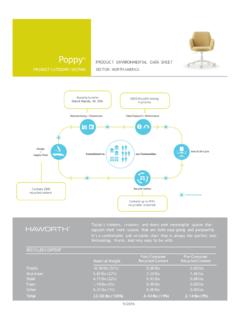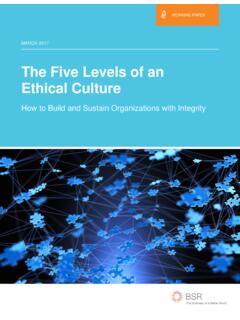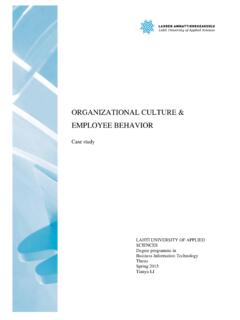Transcription of How to Create a Successful Organizational Culture: Build ...
1 How to Create a Successful Organizational culture : Build It Literally 2 How to Create a Successful Organizational culture : Build It Literally / is Organizational culture ?The term Organizational culture , or company culture , is a relatively recent addition to our vocabulary from the 1980s. Most simply, Organizational culture involves how an organization functions and expresses itself. It s the personality of an organization and encompasses three basic components: 1. Values: what a company does, its mission, and how it represents itself 2.
2 Assumptions: the attitudes, often unconscious, formed through company processes and actions that inform what employees think 3. Artifacts: what a company represents in the form of products, technologies, publications, processes, dress code, location, and architectureCulture creates a sense of order, continuity, and commitment that permeates every aspect of the organization, from how employees interact to customer perceptions. culture is often difficult for an organization to articulate, but its impact is far reaching and influences management, process, products, employee attraction and retention, productivity, reputation, and ultimately the bottom line.
3 Since 1982, when Tom Peters and Robert Wasserman, Jr. sparked interest in the topic through their book In Search of Excellence, Organizational culture has increasingly come to be understood as an asset to enhance matter how strong an organization s planned procedures, culture trumps strategy when the two are not aligned. The best strategic concept won t work in isolation, especially if it conflicts with the overarching culture of a company. For example, Apple Computer s commitment to innovation is cultural, not process driven.
4 As a result, the organization has flourished, virtually untouched by competition and with a distinct culture all its own. A Google search for company culture turns up over 290,000,000 hits in a fraction of a second, garnering headlines from Forbes, The Wall Street Journal, and other business publications. Why does culture earn so much press? Because it s critically important, often misunderstood, and influences employee engagement all of which ultimately affect financial performance. Whether conscious or subconscious, culture evokes strong emotions that motivate employees to perform.
5 Beyond engaging employees for the sake of revenue, a healthy culture can also foster collaboration and innovation. While much of what comprises culture is amorphous, research suggests that architecture, interior design, and furnishings provide a tangible way to support or even change the culture of an provides a foundation for we agree that culture is important, shouldn t workspaces reflect it? Most modern offices are built around functional considerations increased density, one-size-fits-all workstations, office reductions, etc.
6 Usually because workspace is viewed as a cost rather than a driver of performance. Recognizing space as a way to support productivity and company goals begins by first defining existing Organizational culture , comparing that to desired culture , and then designing workspaces to expressly support the elements needed for change. Thus, the first step in linking culture to workspace is to understand an organization s Rex Miller, Mabel Casey, and Mark Konchar, Gallup, Andrew J. Oswald, Eugenio Proto, and Daniel Sgroi, Gallup, percent of the American workforce is not low morale on the job comes at a high cost.
7 In 2014, the Department of Economics at the University of Warwick found that a happy worker is 12 percent more productive than the average worker, and unhappy workers are 10 percent less In fact, disaffected workers cost American businesses roughly $450 to $550 billion each year in lost An Organizational culture that motivates employees can yield high , Assumptions, and Artifacts Define Organizational Culture3 How to Create a Successful Organizational culture : Build It Literally / types can influence the effectiveness of an organizationIn 1983, after reviewing various studies, Robert Quinn and John Rohrbaugh determined that two major dimensions account for the broad range of indicators that make up an Organizational These dimensions became the foundation for what is now known as the Competing Values Framework.
8 The concept emerged from research that demonstrated a link between culture types and Organizational effectiveness. Two major dimensions emerged consistently: 1. Flexibility versus Stability: This dimension focuses on order and control versus adaptation and dynamism. (Some organizations, for example, value managers who are adaptable, while other organizations prefer managers who are consistent.)2. Internal versus External: This dimension differentiates an internal orientation intent on integration, collaboration, and unity from an external focus on competition, differentiation, and rivalry.
9 (Some organizations prioritize harmonious internal relationships and processes, while others focus externally on establishing a market niche.)Note that this framework was developed as a positivist model with four core values that represent opposite, or competing, approaches for driving innovation and effectiveness (hence the name, Competing Values Framework). The opposing dimensions represent the values, assumptions, and artifacts of an organization the very components that define Organizational culture .
10 Diagnosing culture establishes a starting point for positive company that doesn t understand its own culture is like a person without an identity. To encourage change and positive growth, the first step is to analyze the existing culture . Even if an organization is relatively satisfied with its culture , assessment is still important to provide a common language for a conversation about current culture , workspace, and direction for the future. It s typical to discover a difference between existing and desired culture , so diagnosis is critical in order to effectively implement a space that both supports desired culture and helps Create ideal working environment.








